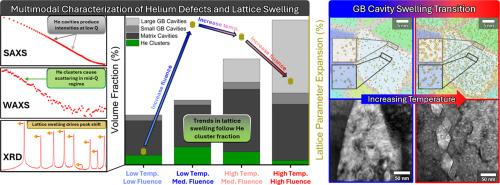微观结构信息同步加速器x射线分析揭示了超细晶钨中的氦缺陷转变
IF 3.2
2区 工程技术
Q3 MATERIALS SCIENCE, MULTIDISCIPLINARY
引用次数: 0
摘要
由于核嬗变或离子注入导致材料中不溶性气体缺陷的形成涉及杂质原子的扩散形成原子缺陷团簇,这些原子缺陷团簇合并成气泡或空腔,最终使材料性能下降。透射电子显微镜(TEM)在解析亚纳米气体团簇方面的能力有限,而x射线衍射(XRD)提供了有关局部原子变化的信息。在本研究中,通过多模态缺陷表征活动,结合tem小角x射线散射(SAXS)分析、XRD晶格参数测量和广角x射线散射(WAXS)可到达的倒易空间区域的纳米级He簇量化,探索了氦(He)注入超细晶钨。适度的高温注入可以产生高浓度的亚纳米级He团簇和均匀分布的小腔,这些都与晶格膨胀有关,并通过互补的原子模拟得到进一步证实。升高的注入温度促进这些缺陷向晶界扩散,导致晶格松弛和大晶界空洞的生长,在SAXS分析中表现为双峰尺寸分布。总的来说,我们的结果证明了多模态同步加速器x射线分析在弥补微尺度He腔量化和原子尺度缺陷分析之间的差距方面的实用性。本文章由计算机程序翻译,如有差异,请以英文原文为准。

Microstructurally informed synchrotron x-ray analysis revealing helium defect transitions in ultrafine grained tungsten
The formation of insoluble gaseous defects in materials due to nuclear transmutation or ion implantation involves the diffusion of impurity atoms to form atomic defect clusters that coalesce into bubbles or cavities and ultimately degrade the material properties. Transmission electron microscopy (TEM) is limited in its ability to resolve sub-nanometer gas clusters whereas X-ray diffraction (XRD) provides information pertaining to local atomic changes. In this study, helium (He) implanted ultrafine grained tungsten is explored through a multimodal defect characterization campaign combining TEM-informed Small Angle X-ray Scattering (SAXS) analysis, XRD lattice parameter measurements, and nanoscale He cluster quantification from a region of reciprocal space accessible via Wide Angle X-ray Scattering (WAXS). Moderate elevated temperature implantations are shown to produce high concentrations of sub-nanoscale He clusters and small, homogeneously distributed cavities, which collectively are linked to lattice expansion and further substantiated through complementary atomistic simulations. Increased implantation temperatures encourage the diffusion of these defects to the grain boundaries (GBs), leading to lattice relaxation and the growth of large GB cavities manifesting as bimodal size distributions in the SAXS analysis. Overall, our results demonstrate the utility of multimodal synchrotron X-ray analysis in bridging the gap between microscale He cavity quantification and atomic-scale defect analysis.
求助全文
通过发布文献求助,成功后即可免费获取论文全文。
去求助
来源期刊

Journal of Nuclear Materials
工程技术-材料科学:综合
CiteScore
5.70
自引率
25.80%
发文量
601
审稿时长
63 days
期刊介绍:
The Journal of Nuclear Materials publishes high quality papers in materials research for nuclear applications, primarily fission reactors, fusion reactors, and similar environments including radiation areas of charged particle accelerators. Both original research and critical review papers covering experimental, theoretical, and computational aspects of either fundamental or applied nature are welcome.
The breadth of the field is such that a wide range of processes and properties in the field of materials science and engineering is of interest to the readership, spanning atom-scale processes, microstructures, thermodynamics, mechanical properties, physical properties, and corrosion, for example.
Topics covered by JNM
Fission reactor materials, including fuels, cladding, core structures, pressure vessels, coolant interactions with materials, moderator and control components, fission product behavior.
Materials aspects of the entire fuel cycle.
Materials aspects of the actinides and their compounds.
Performance of nuclear waste materials; materials aspects of the immobilization of wastes.
Fusion reactor materials, including first walls, blankets, insulators and magnets.
Neutron and charged particle radiation effects in materials, including defects, transmutations, microstructures, phase changes and macroscopic properties.
Interaction of plasmas, ion beams, electron beams and electromagnetic radiation with materials relevant to nuclear systems.
 求助内容:
求助内容: 应助结果提醒方式:
应助结果提醒方式:


